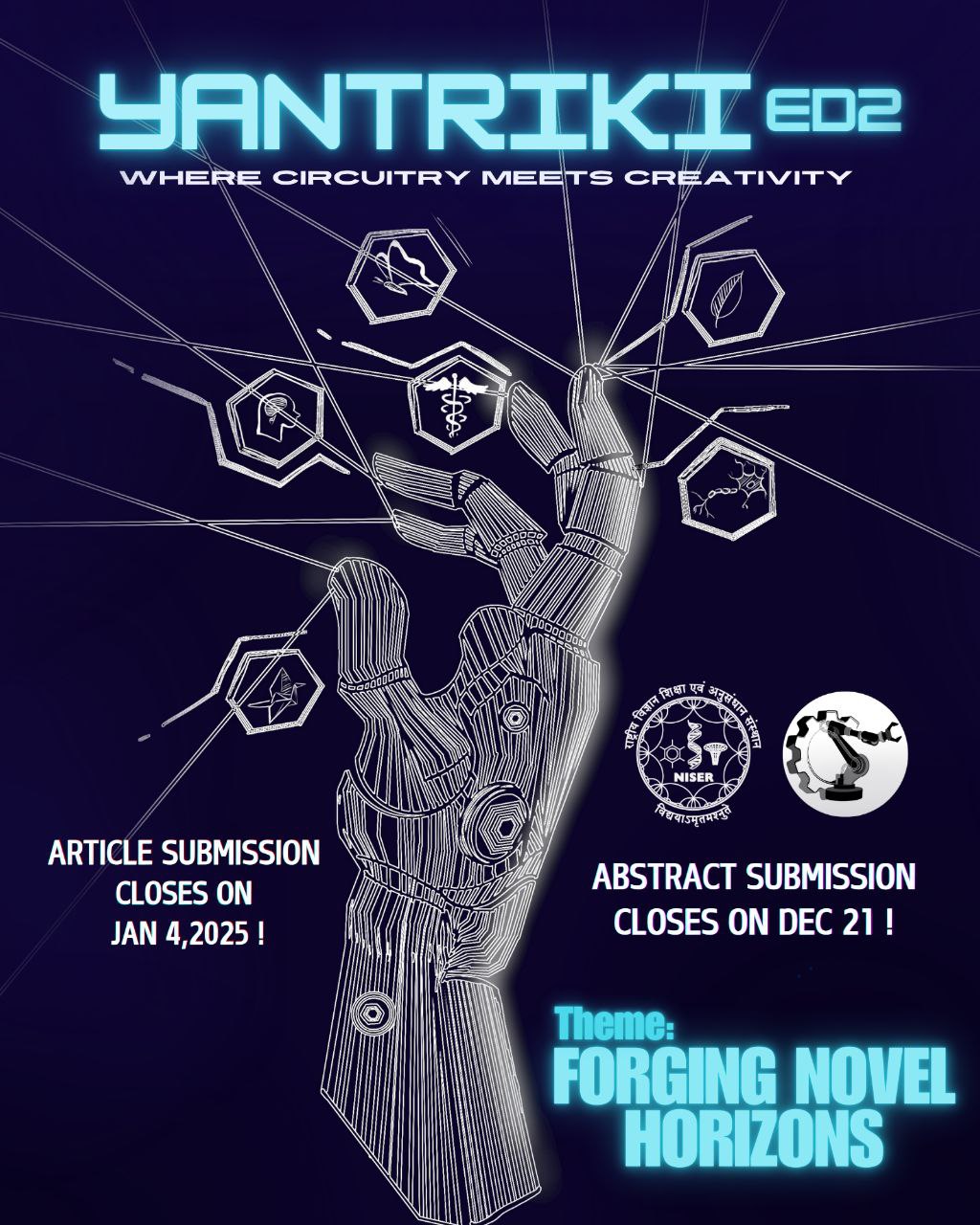Yantriki ed2
Yantriki: Where Circuitry Meets Creativity
Yantriki is an annual publication by the RoboTech Club at NISER, aimed at making robotics and technology accessible to everyone. Whether you’re a beginner or an expert, Yantriki offers project blogs, research articles, and tutorials to expand your knowledge.
We welcome nationwide contributions, providing a platform for sharing ideas and work. From project reports to cutting-edge research, Yantriki connects innovators. Submit your articles for a chance to be featured and enjoy exciting perks like customized gifts.
Join us as we explore the future of robotics and technology together!
Information regarding Yantriki Ed2:

Overview of this edition
The Theme for Yantriki ed2 is “Forging Novel Horizons”. This year, Yantriki serves as an exposé on the hidden bizarre connections robotics has with any other field one can think of. The fields of soft robotics and biomimicry serve as examples. This edition will explore how various fields other than traditional robotics are incorporated into designing and enhancing robots or how the field of robotics is helping in the advancement of different fields, with emphasis on the former.
Abstract Submissions Over.
Spot Entries Open
Submission Process:
The process is plain and simple. Just fill the form and adhere to the theme. You can contact us if you need any help, but make sure to submit by March 31.
Do surprise us!!!
Important Dates:
- Abstract Submission deadline: Dec 21, 2024 11:45 PM
- Article(s) Submission deadline:
Apr 7, 2025 11:45 PM
General Instructions:
- Maximum number of authors allowed are two.
- All articles must be written in clear, well-structured English. Please note that each article will go through a screening process, and submissions deemed unintelligible may be rejected.
- Ensure that the article does not contain spelling or grammatical errors (We recommend using spelling and grammar check software prior to submission).
- Articles will be checked for plagiarism and disqualified if found plagiarized beyond acceptable limits.
- The authors must ensure that the article has not been previously published. If selected, the author has no right to publish the article elsewhere.
- One author can submit more than one article but they should not make multiple submissions of the same article.
- Intelligent, well-researched criticism is encouraged, but the presence of any offensive, vitriolic attacks or ad hominem arguments will lead to disqualification.
Format:
- Articles (excluding cover page) should not exceed 4 pages, including all visuals and references.
- Scanned copies of handwritten articles will not be accepted.
- Authors are requested to adhere to the template provided below to adhere to ensure consistent formatting:
- If the article does not contain any mathematical typesetting, then authors can make submissions according to this template. Avoid changing the file format to maintain universal accessibility.
- If the article includes any mathematical typesetting, please use this LaTeX template for submission. Submit both the .tex file and the compiled PDF. Don’t worry—LaTeX is beginner-friendly, and we encourage everyone to give it a try! This link will be useful to start using the template on Overleaf.
- There should be no mention of the identity of the author/co-author or their institute in the article apart from where it’s already mentioned on the cover page.
- Relevant, high-resolution visuals/illustrations are encouraged to enhance clarity and engagement.
- Proper Citation: All references and sources must be cited appropriately within the article. Use a consistent citation style (APA 7th edition) to ensure clarity and academic integrity. Each reference should include all necessary details for readers to locate the original source.
- Image Attribution: Any images or diagrams used must be properly credited:
- From the Internet: Ensure that any internet-sourced images are available under a Creative Commons license. Include a source link alongside the image.
- Self-Created Images: If you’ve created the images yourself, please
indicate this clearly.
Content Expectations:
- Originality: Articles should present unique insights or depths to the subject matter.
- Engagement: The audience for these articles can range from experts to people new to the field. Efforts should be made to make the article understandable andbasic to a general audience. While rigor is appreciated, simplicity and accessibility must be prioritized in the content delivery of the article.
- Clarity and Relevance: Articles must be structured coherently and focused on how interdisciplinary fields contribute to the innovations in robotics.
Review:
The articles will be evaluated by a panel of three esteemed experts, for:
- Theme Relevance: Alignment with the theme “ Forging Novel Horizons.”
- Structure and Engagement: Organization, readability and engagement.
- Insight and Depth: Analytical depth and clarity of insights on robotics advancement.
After submission, authors are requested to stay vigilant, as judges may provide suggestions or request minor revisions. These revisions will be necessary for the final incorporation of the article in Yantriki. Authors are expected to make the required updates promptly to ensure a cohesive publication process.
Perks:
If your article is selected, it will be published in Yantriki ed2. The authors of the published articles will also receive a copy of the magazine along with an electronic kit.
Terms and Conditions:
- The editing and publishing of content is at the discretion of the Yantriki team.
- Anonymity may be requested to the editorial board before the article is published.
- By submitting, authors grant the Yantriki magazine the right to publish and distribute their work.